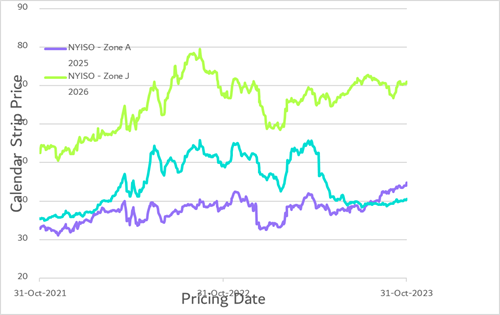Smartest Insight | Issue 141

Our weekly company round-up covers the key market and industry news in one place, so you don’t have to look any further to stay ahead.
November 02, 2023
Market Update:
The storage expectation for the week ending 10/20/23 was for a build between 78-82 BCF. Actual storage came in at 74 BCF, slightly bearish, however the market responded by increasing $0.20/MMBtu on the day before peaking at $3.62 on the prompt month for natural gas. Since then, we've had a volatile week where prices have traded between $3.32 and $3.62.
Above normal temperatures for this time of year can be expected through the 8-14 day forecast in the western two thirds of the country. Although most of some PJM, NYISO and NEISO can expect temperatures to continue with below normal temps with snow. In general, the winter forecasts are unchanged with El Nino in place. We can continue to expect a warmer than normal winter across the country.
On the crude oil front, we continue to see volatility that has increased since the Israel - Hamas war. Prices jumped over the weekend up in the $84/barrel range then quickly retreated down about 3%. Concerns that the war will draw in any oil producing nations quickly drive the market in either direction.

Regulatory Report:
Nuclear’s Place Within Global Energy Policies
According to an International Energy Agency (IEA) report, nuclear energy capacity is expected to increase by at least 50% by 2050 due to existing global policies. The report, titled "World Energy Outlook 2023," noted that nuclear energy technologies pose lower risks compared to wind power but are not as low as solar power. After a decade of slow deployment following the Fukushima nuclear plant accident in Japan, changing policy landscapes are creating opportunities for a nuclear comeback.
The IEA's report considered three scenarios for the years 2022 to 2050. Under the "Stated Policies Scenario," based on existing policies, global nuclear power capacity is projected to rise from 417 GW in 2022 to 620 GW in 2050. In the "Announced Pledges Scenario," assuming all government energy and climate targets are met, nuclear capacity would reach 769 GW. In the "Net Zero Emissions by 2050 Scenario," total nuclear capacity would be 916 GW, contingent on limiting global warming to 1.5°C.
In all three scenarios, nuclear energy would represent only 2% of global power generation capacity by 2050, down from 5% in 2022. Renewable energy would make up between 70% and 89% of global power, depending on the scenario, while unabated fossil fuels would no longer contribute to power generation by 2050 in the Net Zero Emissions scenario. The report also highlighted that the share of low-emission sources (renewables plus nuclear) in the global energy mix is set to reach 40% in 2023, marking a significant increase. However, critics argue that the IEA's scenario is not realistic, citing the high costs and complexity associated with new nuclear builds.
NY PSC Plans for Medium- and Heavy-duty Vehicle Electrification
The New York Public Service Commission is addressing medium- and heavy-duty vehicle electrification and electric vehicle (EV) charging load planning in an upcoming proceeding. With some vehicle depots having charging loads of up to 10 MW, the Commission is preparing the grid for all classes of charging vehicles, including light, medium, and heavy-duty. They are also considering new incentives for electrifying buses and trucks, particularly in disadvantaged communities.The Commission is exploring a demand charge alternative proceeding to support electric fleets as demand charges pose a significant financial obstacle, especially as EV adoption rates remain low.
New York is implementing an Advanced Clean Truck regulation, aiming to have 100% of medium and heavy-duty vehicles sold by 2045 be zero-emission. The Metropolitan Transit Authority plans to have around 5,800 zero-emissions buses by 2040, and the state mandates that all new school bus purchases be zero-emissions starting in 2027, transitioning its 55,000 school buses by 2035. The Port Authority of New York and New Jersey also has electrification goals, seeking to replace 50% of non-emergency-response medium and heavy-duty vehicles with zero emissions alternatives by 2035.
Balancing Reliability and Affordability in Capacity Markets
Industry experts discussed potential reforms for wholesale power capacity markets in response to the evolving U.S. energy landscape and extreme weather events at the Nodal Trader Conference. Texas has faced market design issues following the deadly February 2021 winter storm. Peak electricity demand in the state has increased by 11 GW since the storm, while renewable and short-duration energy storage grew by 23 GW, but long-duration dispatchable resources only increased by 3 GW. The cost of reliability has risen as well, with rule changes increasing ancillary service costs by over $1 billion over the summer. A minimum price adder for operating reserves is set to be implemented in Texas by ERCOT, aimed at addressing reliability concerns. The state's Public Utility Commission also approved a capacity market construct known as a performance credit mechanism.
Some experts believe there is a need for a balanced approach between reliability and affordability, considering the evolving resource mix and extreme weather risks. Forward capacity markets can continue to provide residual revenue outside traditional energy and ancillary service markets, particularly for compensating generators for flexibility. Capacity accreditation, measuring an individual resource's contribution to system reliability, may become more crucial in a grid dominated by weather-dependent renewable sources.
